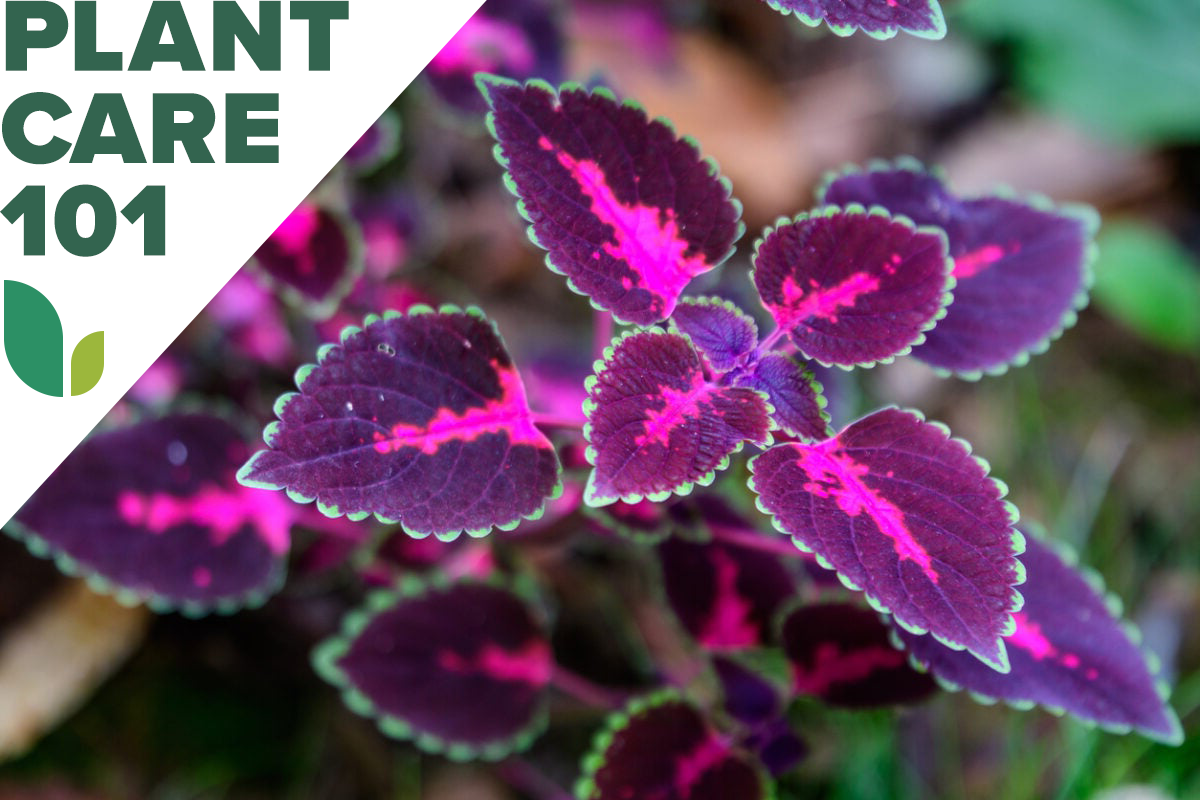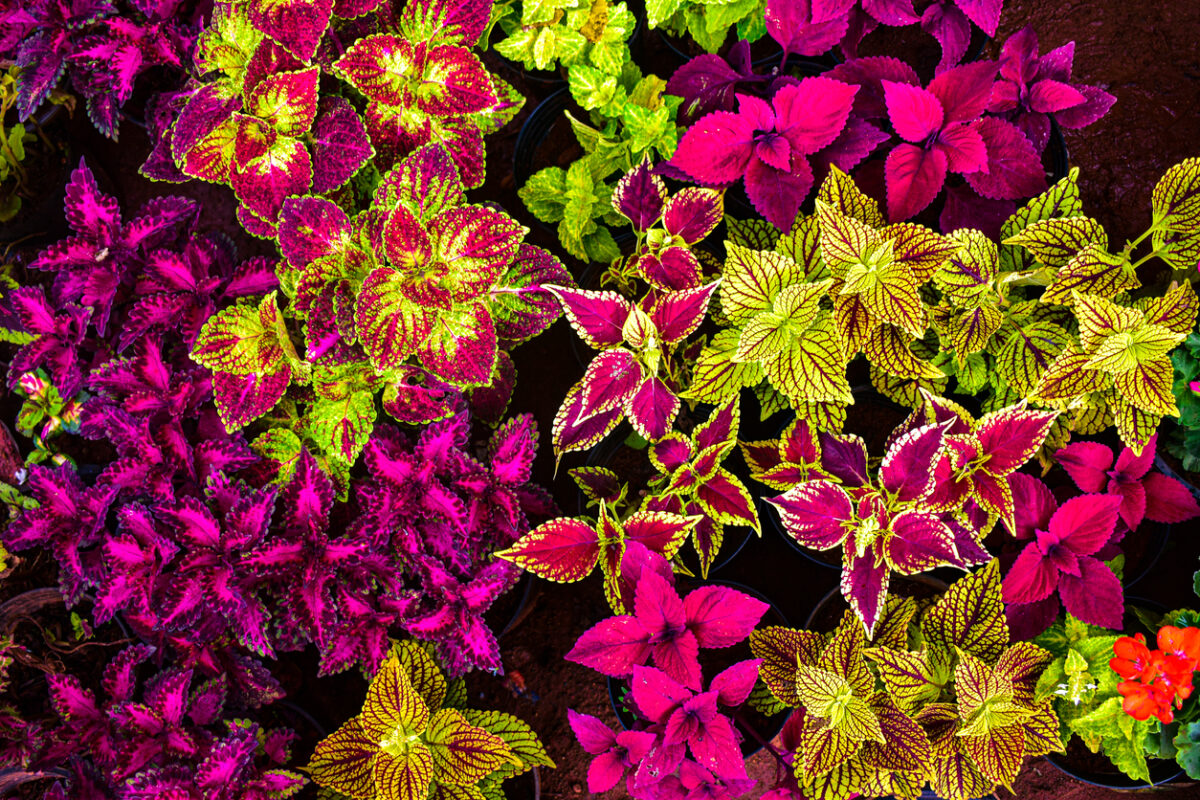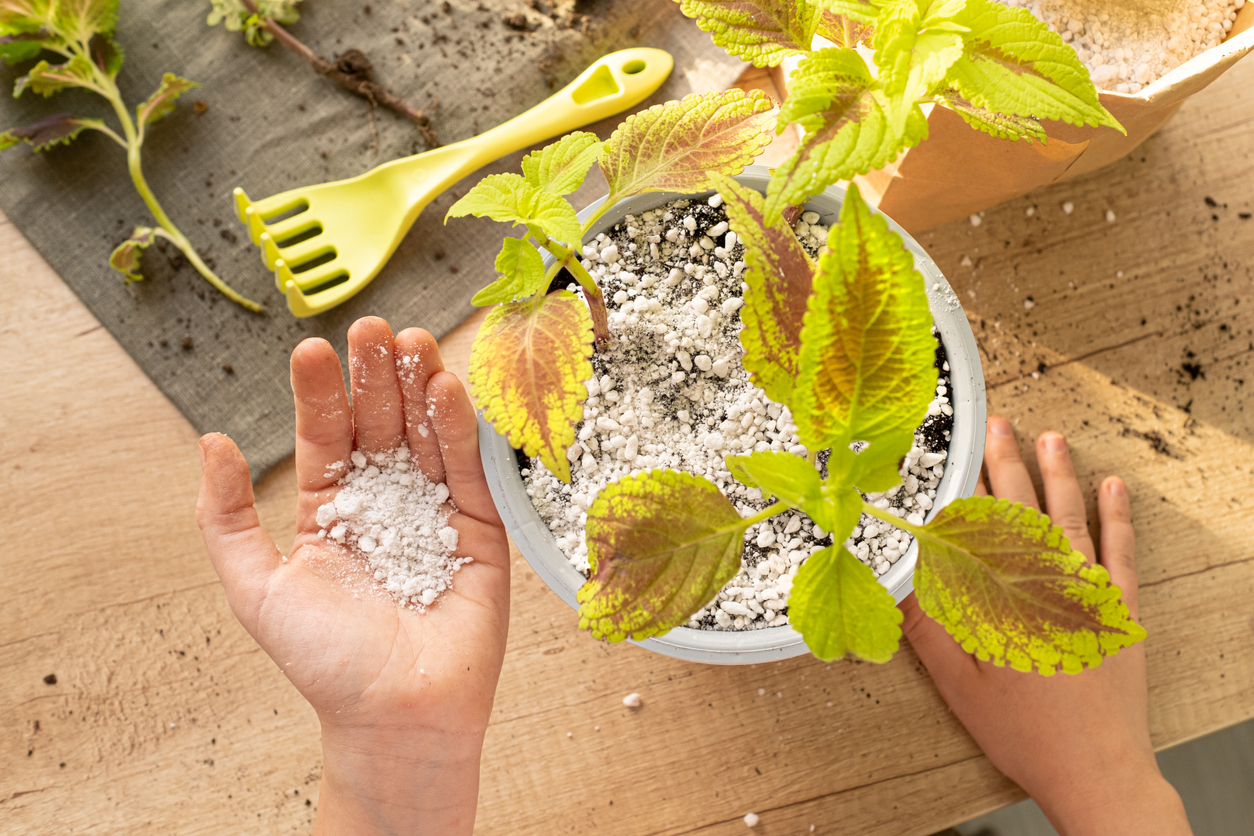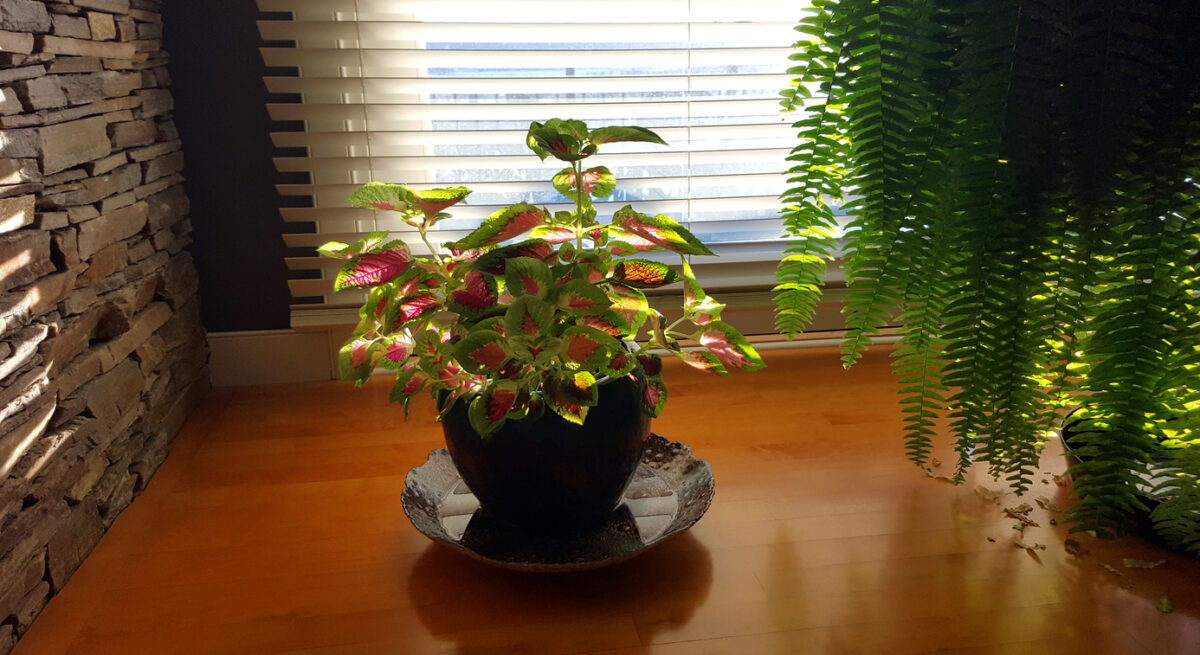

We may earn revenue from the products available on this page and participate in affiliate programs. Learn More ›
There’s a reason that coleus plants have been popular since the 19th century—after all, how often are ornamental plants also low-maintenance? If you’re looking for a plant that anyone can grow well, consider adding colorful coleus to your garden.
Growing coleus is a cinch, even for beginner gardeners. No matter if you use them in garden beds or plant them in containers, coleus may be one of the most visually rewarding additions to your garden. Unlike many other types of plants, coleus is grown for its colorful foliage instead of its flowers.
Press on to learn more about coleus care and what these beautiful plants need from you so they can thrive.
RELATED: 14 of the Fastest-Growing Houseplants for a Nearly Instant Indoor Garden
Growing Coleus at a Glance
Common Name: Coleus, painted nettle
Scientific Name: Coleus spp.
Hardiness Zone: Cold hardy in Zones 10 through 11
Soil: Well-draining, pH 6 to 7
Light: Shade, partial shade, or full sun
Water: Medium
Food: General-purpose fertilizer
Propagation: Seeds or cuttings
Safety: Some species are a mild irritant, and some are toxic to animals

Coleus Characteristics
The Coleus genus contains many species and varieties, therefore you may come across coleus that are upright annuals or herbaceous perennials. These stunning plants fall into the Lamiaceae (mint) family, though coleus foliage isn’t especially aromatic.
Growing between 6 and 36 inches tall, these square-stemmed beauties are often as wide as they are tall. What stands out the most on coleus are the textured leaves, which have teeth or lobing and show off irregular patterns. They also exhibit exceptional color combinations of yellows, pinks, purples, magentas, or greens—coleus colors cover essentially the entire spectrum, all except for true blue. Coleus plants also grow small blue to white nettle-like flowers, but some gardeners opt to remove them.
Native to the tropics of Southeast Asia and northern Australia, coleus plants have been hybridized to suit many types of environments. With around 300 coleus species and over 1,500 different varieties available, there’s likely a coleus that’s just right for your garden. Many varieties are shade-tolerant, while others thrive in full sun. Be sure to select ones that are suited to your area and the lighting conditions they’ll grow under.
Recommended Coleus Varieties
Because there are so many coleus varieties out there, it can be a bit of a research mission to find a favorite. Likewise, their botanical names can be confusing. For years, experts categorized coleus under Plectranthus (and about 70 species remain in that genus), but most were later returned to the coleus name. Choose a coleus variety that suits the growing conditions of your backyard and local climate. Here are some of our favorites:
- Wasabi Coleus: With large, scalloped leaves and chartreuse coloring, this grower does well in full sun or shade.
- Henna Coleus: Boasting frilly leaves of chartreuse, magenta, and burgundy, this newer type of annual coleus thrives in full sun.
- Stained Glassworks Molten Lava Coleus: This vibrant red and burgundy coleus is one that suits full sun, sun to partial shade, or even light shade.
- Watermelon Coleus: Appropriately named for its watermelon coloring (complete with dark spots to emulate the fruit’s seeds), this bold coleus suits shade and full sun in areas of high relative humidity.
RELATED: 14 Long-Lasting Flowers for Your Yard

Planting Coleus
Coleus steals the show in a garden bed, and the plant grows well in container gardens, too. As these plants originate in tropical conditions, they’re definitely not fans of cold weather. If you’re in a colder region, your coleus plant may not survive, even with the best care. They survive as annuals in all but USDA Zones 10 and 11, so they often grace pots or garden beds just for the summer.
If you live in a hotter region and you want a coleus to last through winter, be sure to research the variety you want to plant, or double-check at the nursery about varieties that suit your climate before digging a hole and plopping them in the ground.
Providing that your timing is right, and you plant your coleus in suitable soil, these easygoing plants are likely to fare very well in warm zones. Coleus plants like moist, loose soil with a pH of 6 to 7 and a high organic matter content. The soil needs to be well-draining, which you can encourage by adding compost or sand into a heavier soil.
In the right environment, coleus plants can live for several years, and you can use them as starters for new coleus plants. Read on to learn more about coleus plant care—namely, how and when to plant coleus in your garden.
When is the best time to plant coleus?
Since coleus is native to tropical climates, gardeners must be aware of frost dates in their region. Start coleus plants from seeds indoors approximately 8 to 10 weeks before your last frost date. Once outdoor soil temperatures are consistently above 60 degrees Fahrenheit and the danger of frost has passed, you are in the clear to move your starters outside to a container or garden bed.
Where can coleus grow?
In this plant family of many cultivars, you can find a coleus that can grow in areas of shade, partial shade, or full sun. Coleus light requirements vary; knowing how to care for coleus in terms of light or shade comes with knowing a specific variety’s details. Luckily, this information can be found in online descriptions or on plant tags. Keep in mind that these plants may wilt in full sun or become leggy in full shade if they’re not meant for those conditions. Another thing to note is that planting a coleus garden in a location with morning sun and dappled afternoon shade will help the plants offer their best leaf colors.
As a general rule, coleus cultivars with darker leaves tend to manage sunlight better than those with lighter colored leaves. Be sure to choose an area for your coleus that’s protected from the wind, as their stems are prone to breakage.
How do you plant coleus?
Coleus grows from seed or cuttings, or you can buy an established plant from a nursery.
- Start from seed indoors approximately 10 weeks before your area’s last frost.
- Choose a spot in the garden or container with the right amount of sun for your coleus plant, in an area protected from the wind. Space multiple coleus plants about 12 inches apart.
- Place the coleus in fertilized soil with the base of the stem at the same level it was in the pot, and tease out the roots to encourage growth.
- Remove air pockets by tamping down lightly on the soil.
- Water thoroughly after planting.
Can you grow coleus in containers?
Coleus plants grow just as well in containers as they do in garden beds, making them an excellent plant for balconies, decks, or patios. Coleus in pots can stay in the same container year round, and they are easy to bring indoors over the winter. Select a pot or container that’s just a few inches larger than the root ball, and it will make itself a happy home. As for materials, ceramic or plastic containers are best, as porous materials like terracotta may cause soil to dry out faster.
The soil requirements for container coleus remain the same, and you must ensure that your coleus has well-draining soil and drainage holes at the bottom of the container to prevent overwatering.
RELATED: The Best Plants for Every Room of the House
Watering Coleus
Being a tropical plant, coleus needs regular watering to be happy. The morning is the best time to water them, as it starts their day hydrated and equips them to better manage through the heat of the day. While cool water is fine for outdoor plants, indoor coleus prefers room temperature water.
Coleus often require daily watering, but their needs differ depending on their environment. For example, container plants will need water more frequently than those in garden beds. When in doubt, add water when the top inch or two of soil is dry. If this soil is still damp, hold off on adding more water.

Fertilizing Coleus
Coleus plants love regular fertilizing and grow best in a rich soil. When you plant coleus seeds, cuttings, or plants, use a granular general-purpose fertilizer that has equal parts nitrogen, phosphorus, and potassium.
Each month after planting, gardeners need to add some more fertilizer or nutrient-rich compost to encourage foliage growth. Some gardeners opt to use a water-soluble or liquid fertilizer for their monthly fertilization, which can make the plant more lush and rich in color. Container coleus plants may need to be supplemented more often with water-soluble fertilizer, closer to every 2 weeks.
Pruning Coleus
Coleus plants do bloom occasionally, but many gardeners trim back or remove coleus flower stalks, since the plant’s leaves are eye-catching enough on their own. Clipping the spikes prevents the plant from wasting energy creating flowers. You can cut these flower spikes as they appear, or pinch off the flowers themselves. This helps extend the life of the coleus and encourage the growth of more colorful foliage.
Regardless of whether you let your coleus’s flowers grow or cut them off, these plants need to be pruned by mid-summer when grown as perennials. If left to overgrow, branches can snap under the weight of the plant’s foliage. Gardeners can safely clip coleus at any spot where two stems or two leaves are growing from the plant.
Propagating Coleus
Coleus plants have so many species and varieties that there are options for growing more plants from seed or from cuttings. Propagating coleus via cuttings takes only 2 to 3 weeks, and it’s quite simple—just ensure you take your cuttings before your first frost date.
Cut 4 to 6 inches off the top of a mature plant, and remove the leaves growing from the bottom half of the cutting. Take the cutting and place it in a container of water that’s full enough to cover where the leaves were removed. Once you see roots appear on the cuttings, you can transplant the propagated plants to small pots, and keep them near a sunny window through the winter.
Safety Considerations
For the most part, there’s not much to worry about with coleus plants. That said, some species of coleus contain trace amounts of mildly toxic elements, including a compound called diterpene coleonol, in the oils and sap. Coleus amboinicus is a variety that’s more commonly associated with toxic reactions. These toxins aren’t a major risk we have to worry about as humans; the most common issue would be mild or minor skin irritation from exposure to or ingestion of the plant.
The toxins present in some species are more of a threat to our animal friends. When dogs, cats, and other animals get coleus poisoning, it can cause irritation and more severe symptoms, including vomiting, diarrhea, weakness, and more.
Potential Pests and Diseases
Coleus care is incredibly easy, and an additional perk of this plant is that garden pests and diseases aren’t usually an issue. One potential problem that may occur is root rot if the soil is too wet. This can be easily bypassed by making sure the soil drains well and that containers holding any coleus plants have working drainage holes.
As for pests, there is the potential for aphids, spider mites, mealybugs, and whiteflies. If you see these insects on a coleus plant, you can dip a cotton ball in rubbing alcohol and wipe the bugs away.
RELATED: 14 Symptoms of an Unhappy Houseplant (and How You Can Treat Them)

Overwintering Coleus
Be aware of your upcoming first frost date and bring your coleus indoors before the temperature dips too low, usually about 45 degrees Fahrenheit. Due to their tropical nature, coleus plants are quite cold-sensitive, and they’ll be one of your first garden plants affected by frosty weather.
With enough time to prepare, gardeners can salvage the coleus from their garden beds, take cuttings for next year’s garden, or bring their coleus plant containers inside for overwintering. Some gardeners might opt to keep their coleus as houseplants after they bring them in for the winter.
If gardeners choose to leave their coleus plants outdoors—especially in cooler climates—it’s highly likely they will not survive the winter, and will require starting from scratch again next year with new seeds or plants. Coleus can survive outdoors in warmer climates, but they need attention through the winter; they must be mulched and watered through these cooler months.
When is the best time to bring coleus indoors?
Due to its tender nature, coleus plants must be brought indoors well before your first frost of the year. Research your area’s first frost date and give yourself a bit of time beforehand to bring your coleus inside, just in case the cold weather hits a little earlier than expected. When you bring a coleus indoors, it needs to adjust to the temperature and light, so don’t be surprised if and when leaves start to drop. This should only be temporary until the coleus plant grows accustomed to the new environment.
How do you overwinter coleus?
Preparing your coleus to move indoors for the winter is fairly simple, but it must be done before the cold weather moves in if you hope to keep the plant for next year’s garden. Here’s how to overwinter your coleus plant:
- Move coleus plants from large planters or garden beds into smaller containers. Get as much of the root ball as possible.
- Repot plants in well-draining soil.
- Cut back the top growth to reduce strain on each plant, which helps them better adjust to an indoor environment.
- Safely kill any existing pests on the plants, and make sure you’re not bringing any bugs inside by soaking the plants’ soil in a solution of 1 part hydrogen peroxide to 4 parts water.
- Place coleus on window sills through the winter.
Looking for more low-maintenance plants? Check out our guides on growing hibiscus, peas, and milkweed.
